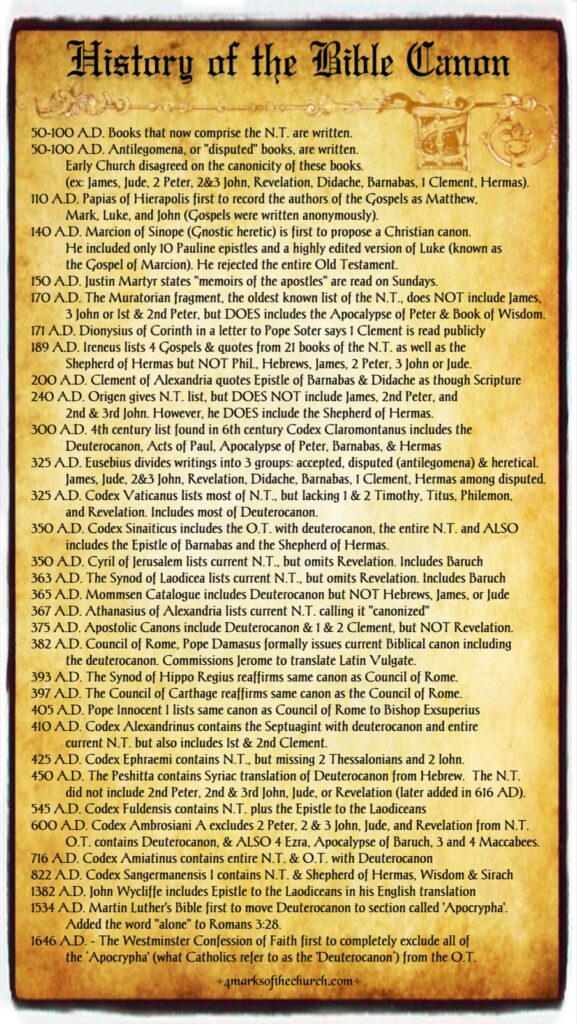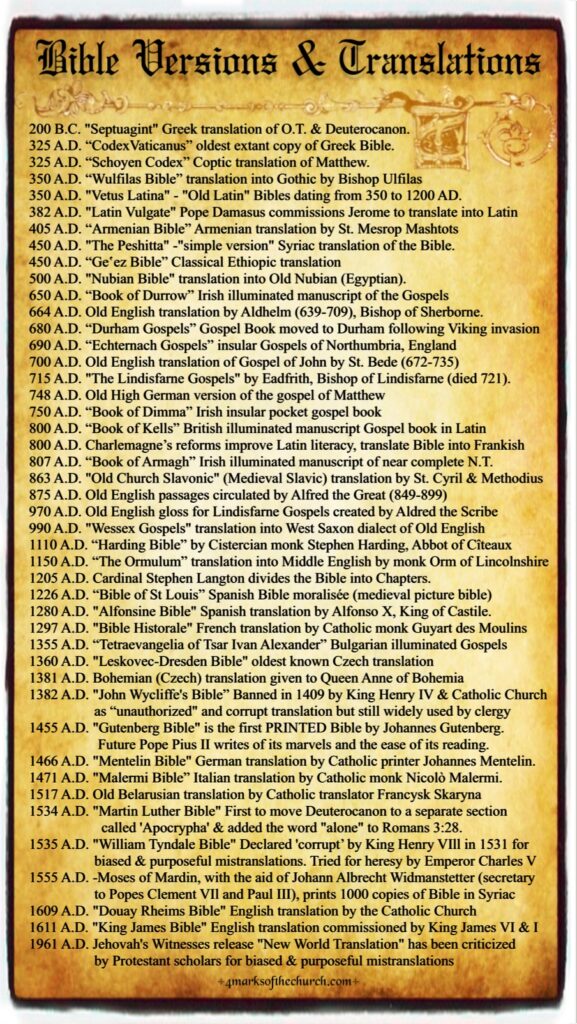
Early Biblical Canons
The canon (the group of books included in the Bible) is often taken for granted because the Bible itself does not contain any list or references as to what books should be considered inspired and thus included in the Bible. It is often assumed that there may have been a list composed by the Apostles, but even a cursory look at history shows that this was not the case. There were actually several competing lists among Christians that varied on which books they included (see a list of early canons below). Not all of the books included in the New Testament were originally accepted by the entire church. Hebrews, James, Jude, 2 Peter, 2 and 3 John, and Revelation were all disputed in the early church and were given the name Antilegomena, or “disputed” books. There were also some books included in these “disputed books” that ultimately did not make it into the final canon, although they were considered Scripture by many early Christians. These included the Shepherd of Hermas, The Didache, the Epistle of Barnabas, The Acts of Paul, the Epistle to the Laodiceans, the Gospel of the Hebrews, the Apocalypse of Peter, and the Epistle of Clement to the Corinthians (1 Clement). When the early Church formally decided upon which books would be included in the New Testament, they used the following criteria to help determine what was Scripture:
1. Apostolic Origin: Was the writing written during the apostolic era by an apostle or a close acquaintance?
2. Orthodoxy: Did the writing conform with what had been taught to the early Church by the Apostles?
3. Universal Recognition: Was the writing already accepted and used liturgically by the whole Church?
The above criteria can basically be summed up as Tradition. After all, 1: before an Apostle could commit anything to writing, they first had to hear it from Jesus and any acquaintances of the apostles would have had to hear it from an Apostle. 2: Before one can determine whether a writing is orthodox, one must first have been taught orthodoxy. 3: Before determining the universal acceptance of a book, one would have to look at which books had been handed down as part of each church’s individual tradition.
Historically speaking, however, even the above criteria falls short. For example, the criteria of Apostolic origin and authorship requires an even greater appeal to Tradition when one considers that the Gospels were all written anonymously and the author of Hebrews is unknown; It is only through tradition that we can claim to know the authors of the Gospels. Questions of authorship not only pertain to the works themselves, but even to chapters and verses contained within certain works. Biblical scholars have pointed out that certain chapters within the Gospels are not found in the earliest extant manuscripts and suggest that they were later additions to the works. Examples include Mark 16:9-20, which is not included in the two earliest remaining manuscripts; the Greek codices Sinaiticus (ℵ01) and Vaticanus (B03). Another example would be John 8:1-11, which tells the story of the woman caught in adultery. The earliest and most reliable Greek manuscripts do not include this story.
Even with the aid of Tradition, the larger Christian world would witness a wide variety of various versions and interpretations of the Bible (see list of Early Versions and Translations of the Bible below). Out of these various versions would grow different traditions that modern Christians would recognize as containing different lists or canons; the Jewish Tanakh, the Catholic and Protestant canons, as well as the canons of the Eastern Orthodox, Oriental Orthodox, and Assyrian Christian churches. So, how did the early Church eventually decide what books to include in the Bible? The decision ultimately comes down to authority. Various biblical canons have developed through debate and agreement on the part of the religious authorities of their respective faiths and denominations. It was only by the authority given to it by Christ that the Church was able to author divinely inspired Scripture and so, naturally, it was also by this authority that the Church was able to authoritatively say which books were to be included in it’s canon of Scripture. This begs the question, however; if different authorities give differing lists, then faulty authorities could include non-inspired writings or leave out important inspired texts. This leaves the question of which authority to follow.
“What if the apostles had not in fact left writings to us? Would it not be necessary to follow the order of tradition, which was handed down to those to whom they entrusted the churches?”
-Irenaeus of Lyons “Against Heresies, 3:4:1” (Written 180 A.D.)
Early Bible Canon Lists
& Manuscripts:
*The list below is not an exhaustive list, but illustrates how the early church viewed Scripture and eventually developed the Bible that we have today;
- The Septuagint (ca. 200 B.C.E.)
- Early Church Father References (96-200 A.D.)
- Marcion of Sinope (ca. 140 A.D.)
- The Muratorian Fragment (170 A.D.)
- Eusebius of Caesarea (ca. 325 A.D.)
- Codex Vaticanus (ca. 325 A.D.)
- Codex Sinaiticus (ca. 325 A.D.)
- Codex Claromontanus (ca. 325 A.D.)
- Cyril of Jerusalem (ca. 350 A.D.)
- St. Catherine’s Monastery (ca. 350-400 A.D.)
- Vetus Latina manuscripts (ca. 350-450 A.D.)
- Synod of Laodicea (ca. 363 A.D.)
- Liber Generationis (ca. 365 A.D.)
- Hilary of Poitiers (365 A.D.)
- Athanasius of Alexandria (367 A.D.)
- Apostolic Canons (ca. 375 A.D.)
- Amphilochius of Iconium (ca. 380 A.D.)
- Synod of Rome (382 A.D.)
- Gregory of Nazianzus (ca. 385 A.D.)
- Synod of Hippo Regius (393 A.D.)
- Jerome of Stridon (ca. 395 A.D.)
- Latin Vulgate (382-410 A.D.)
- Synod of Carthage (397 A.D.)
- Augustine of Hippo (397 A.D.)
- Rufinus of Aquileia (404 A.D.)
- Pope Innocent I (405 A.D.)
- Codex Alexandrinus (ca. 410-430 A.D.)
- Codex Ephraemi Rescriptus (ca. 425 A.D.)
- The Peshitta (ca. 425-450 A.D.)
- Codex Fuldensis (ca. 545 A.D.)
- Codex Ambrosiani A (ca. 600 A.D.)
- Codex Amiatinus (716 A.D.)
- Codex Basiliano-Vaticanus + Codex Venetus (ca 725 A.D.)
- Codex Sangermanensis I (822 A.D.)
Early Versions & Translations
of the Bible:
*The list below is not an exhaustive list, but illustrates how the early church viewed Scripture and eventually developed the Bible that we have today;
- 200 B.C. “Septuagint” Greek translation of O.T. & Deuterocanon.
- 325 A.D. “CodexVaticanus” oldest extant copy of Greek Bible.
- 325 A.D. “Schoyen Codex” Coptic translation of Matthew.
- 350 A.D. “Wulfilas Bible” translation into Gothic by Bishop Ulfilas
- 350 A.D. “Vetus Latina” – “Old Latin” Bibles dating from 350 to 1200 AD.
- 382 A.D. “Latin Vulgate” Pope Damasus commissions Jerome to translate into Latin
- 405 A.D. “Armenian Bible” Armenian translation by St. Mesrop Mashtots
- 450 A.D. “The Peshitta” -“simple version” Syriac translation of the Bible.
- 450 A.D. “Geʽez Bible” Classical Ethiopic translation
- 500 A.D. “Nubian Bible” translation into Old Nubian (Egyptian).
- 650 A.D. “Book of Durrow” Irish illuminated manuscript of the Gospels
- 664 A.D. Aldhelm, Bishop of Sherborne, Old English translations.
- 680 A.D. “Durham Gospels” Gospel Book moved to Durham following Viking invasion
- 690 A.D. “Echternach Gospels” insular Gospels of Northumbria, England
- 700 A.D. St. Bede translates Gospel of John into Old English
- 715 A.D. “The Lindisfarne Gospels” by Eadfrith, Bishop of Lindisfarne (died 721).
- 748 A.D. Old High German version of the gospel of Matthew
- 750 A.D. “Book of Dimma” Irish insular pocket gospel book
- 800 A.D. “Book of Kells” British illuminated manuscript Gospel book in Latin
- 800 A.D. Charlemagne’s reforms improve Latin literacy, translate Bible into Frankish
- 804 A.D. “Charlemagne Bible” produced by Alcuin of York and included Deuterocanon
- 810 A.D. Theodulf of Orleans uses both Hebrew and Septuagint to amend the text of the Vulgate.
- 807 A.D. “Book of Armagh” Irish illuminated manuscript of near complete N.T.
- 847 A.D. Rhabanus Maurus produces commentaries on Wisdom, Sirach, Judith and 1 & 2 Maccabees.
- 850 A.D. “Glossia Ordinaria of Sacram Scripturam” (notes in the margin of the Bible) produced by Walafrid Strabo
- 863 A.D. “Old Church Slavonic” (Medieval Slavic) translation by St. Cyril & Methodius
- 875 A.D. Alfred the Great circulates Old English translations of passages
- 970 A.D. Aldred the Scribe creates an Old English gloss for Lindisfarne Gospels
- 990 A.D. “Wessex Gospels” translation into West Saxon dialect of Old English
- 1110 A.D. “Harding Bible” by Cistercian monk Stephen Harding, Abbot of Cîteaux
- 1150 A.D. “The Ormulum” translation into Middle English by monk Orm of Lincolnshire
- 1205 A.D. Cardinal Stephen Langton is the first to divide the Bible into Chapters.
- 1226 A.D. “Bible of St Louis” Spanish Bible moralisée (medieval picture bible)
- 1280 A.D. “Alfonsine Bible” Spanish translation by Alfonso X, King of Castile.
- 1297 A.D. “Bible Historale” French translation by Catholic monk Guyart des Moulins
- 1355 A.D. “Tetraevangelia of Tsar Ivan Alexander” Bulgarian illuminated Gospels
- 1360 A.D. “Leskovec-Dresden Bible” oldest known Czech translation
- 1381 A.D. Queen Anne of Bohemia is gifted a Bohemian (Czech) translation
- 1382 A.D. “John Wycliffe’s Bible” Banned in 1409 by King Henry IV & Catholic Church
as “unauthorized” and corrupt translation but still widely used by clergy - 1455 A.D. “Gutenberg Bible” is the first PRINTED Bible by Johannes Gutenberg.
Future Pope Pius II writes of its marvels and the ease of its reading. - 1466 A.D. “Mentelin Bible” German translation by Catholic printer Johannes Mentelin.
- 1471 A.D. “Malermi Bible” Italian translation by Catholic monk Nicolò Malermi.
- 1517 A.D. Old Belarusian translation by Catholic translator Francysk Skaryna
- 1534 A.D. “Martin Luther Bible” First to move Deuterocanon to a separate section
called ‘Apocrypha’ & added the word “alone” to Romans 3:28. - 1535 A.D. “William Tyndale Bible” Declared ‘corrupt’ by King Henry VIII in 1531 for biased & purposeful mistranslations. Tried for heresy by Emperor Charles V
- 1555 A.D. –Moses of Mardin, with the aid of Johann Albrecht Widmanstetter (secretary
to Popes Clement VIl and Paul III), prints 1000 copies of Bible in Syriac - 1609 A.D. “Douay Rheims Bible” English translation by the Catholic Church
- 1611 A.D. “King James Bible” English translation commissioned by King James VI & I
- 1961 A.D. Jehovah’s Witnesses release “New World Translation” which has been criticized by Protestant scholars for biased & purposeful mistranslations

